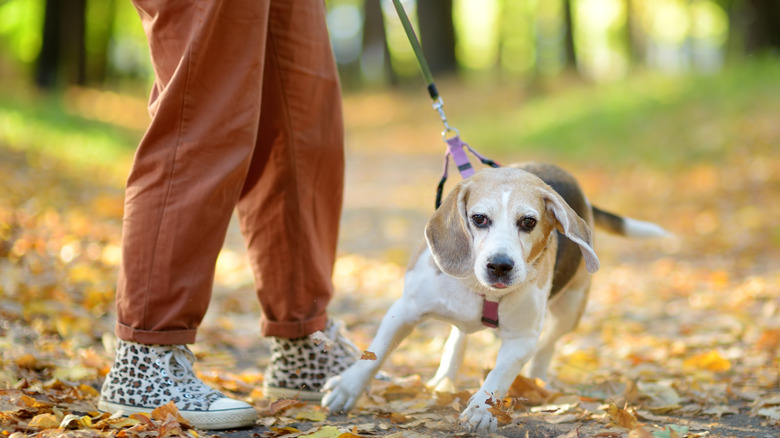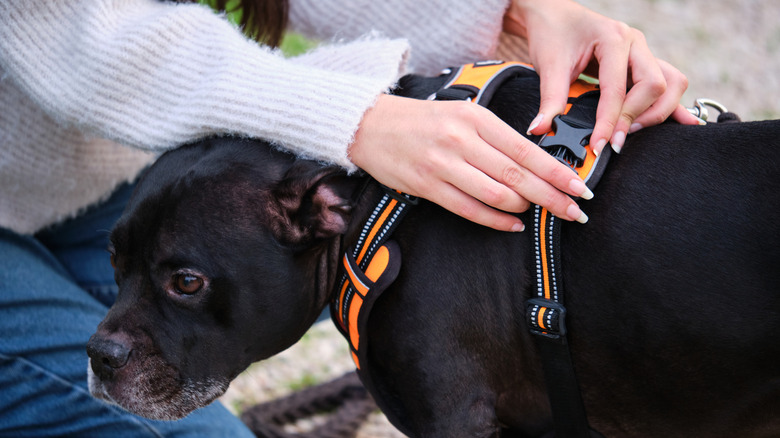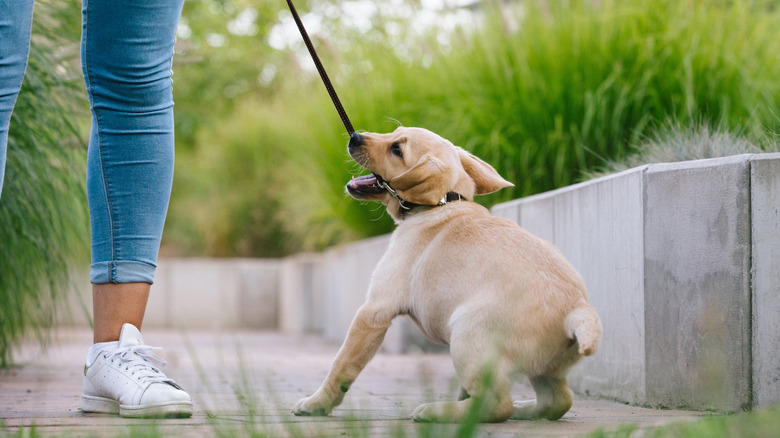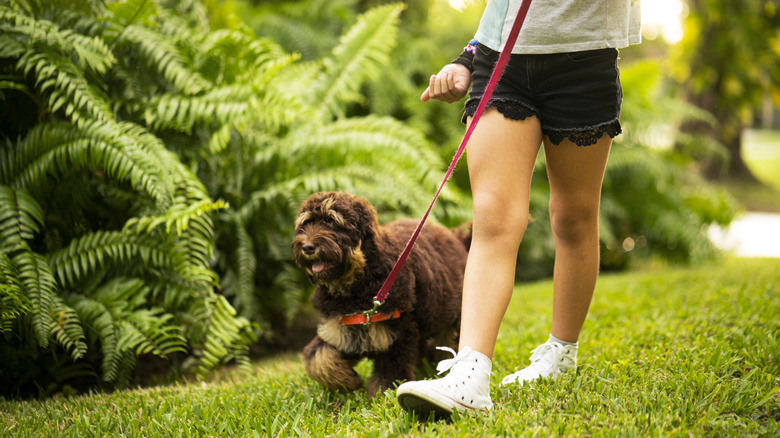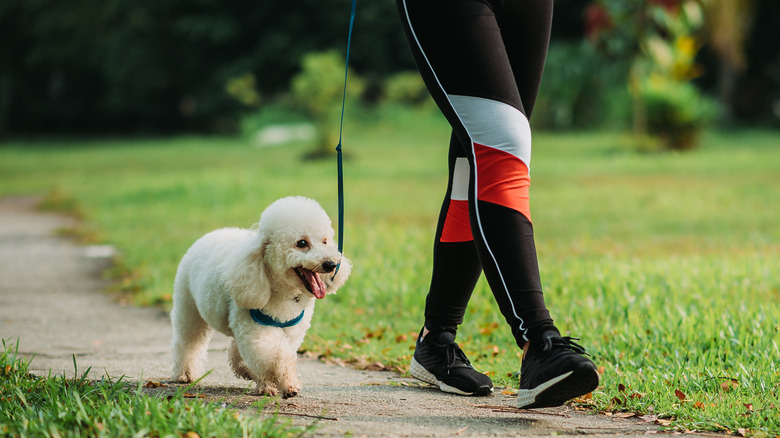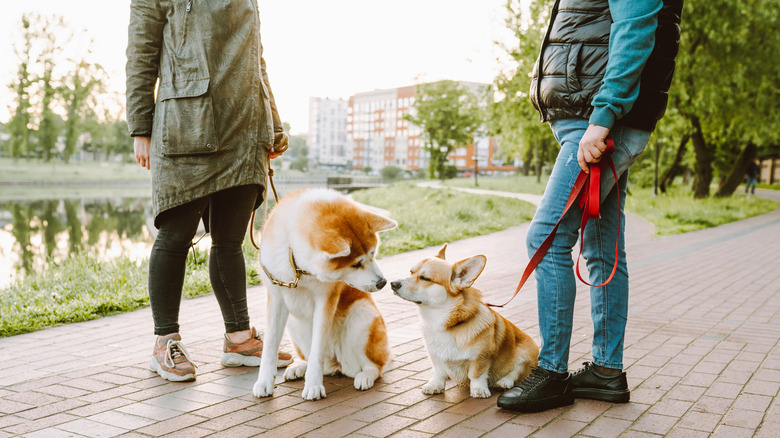5 Tips To Stop Your Dog From Pulling Its Leash (Their Safety Depends On It)
We may receive a commission on purchases made from links.
Teaching a dog how to walk on a leash properly is extremely important. You don't want to be yanked down the road every time you take your pooch outside, and keeping them leashed in public places can help you avoid conflicts with other canines or wildlife, ensuring their safety. Not to mention, depending on your local laws, it can be illegal to have your dog off-leash in certain areas.
Beyond these concerns, lead pulling could have significant negative health impacts for you and your canine. According to a 2022 review published in VetRecord, "Excluding bites, being pulled over while walking on a lead is the leading cause of non-fatal dog-related injuries in the UK." Additionally, leaving this behavior unchecked could lead to less exercise and more weight gain, along with a higher "risk of permanent tracheal, laryngeal, oesophageal and ophthalmic damage in all dogs," especially brachycephalic breeds.
But stopping your pooch from pulling on their leash can be difficult and take a lot of patience. Luckily, there are many tips and techniques that can help you leash train your dog. The goal is to get your pup to walk with you on a relaxed leash. However, it definitely takes time. Dogs are not born knowing how leashes work; it's up to their owners to teach them with diligence, composure, and kindness.
Use the right equipment
There are way too many options these days, and it can be all too easy to get swept up in finding the absolute best dog leashes and other equipment to make training a breeze. And while it's true that some products are generally better than others for this process, you really have to figure out what works for your dog. Usually, retractable leashes aren't the best training tools, because the more your pup pulls, the more leash (i.e. freedom) they get. A six-foot rope leash is going to be your best bet.
Regarding collars and harnesses, dog trainer Fernando Camacho says: "There is no one right tool for everyone and every dog in every situation. And the only way to find what's right for you and your dog is a little old school trial and error." Some of his favorite leash training tools for dogs who pull are the front-attaching harness and the slip lead. Find what works for both you and your pup, and you'll be off to a great start!
Don't walk when they pull
You can employ several methods to leash train your dog, but one thing these approaches all seem to have in common is the advice to stop walking any time they pull or exhibit other unwanted behavior. Yes, it's time consuming. It takes patience and consistency, but dogs love walking, so if you keep moving forward while they yank the leash, you are inadvertently rewarding them for bad behavior.
According to dog trainer Karen B. London (via Kinship), you can do two different things each time your dog pulls on the leash. The first choice is to stop in your tracks and not move forward again until there is slack in the leash. "You may have to stop again three seconds later and do the same thing, and that's OK. Just be consistent about refusing to let them pull," London says.
Your second option is to turn around and walk in the opposite direction every time they pull. This puts your pup behind you for a second or two, meaning the pulling will stop, at least for a moment. Depending on how often your dog pulls, this could get a little dizzying! The most important thing is to not reward pulling in a consistent manner.
Reward good behavior
Just as you don't want to reward bad behavior, you do want to make sure to acknowledge your pup for desired actions. In this case, that means any time they walk on a leash without pulling. Rewards can come in the form of verbal praise, your pup's favorite high-value training treats, or another fun moment of celebration.
Don't be afraid of rewarding them too much. Training sessions are all about praising good behavior when you notice it. "By reinforcing desired behaviors it's more likely that those will occur again, and the not so desirable behaviors will occur less," certified professional dog trainer Nicole Ellis explained to PureWow.
Be consistent
Dogs are trainable, but only if they receive consistent instructions. This is very difficult to do! We're all busy and don't have an endless amount of patience. One way to make sure you can easily remain unflinching with the behavior you praise during your leash training sessions is to time them. Keep them short and hyper-focused.
If you're running late to work and only have a few minutes to let your pup out to do their business, that may not be the best time to try leash training. But if you are planning a 20-minute walk around the neighborhood, that is prime time to enforce the behavior you want to see from your pup. With all the stopping or turning around, you may not get very far distance-wise in that time, but you could make leaps and bounds in how your pup understands walking on a leash.
Stay calm
The most important thing you can do while leash training your pup is stay calm. It may take your pooch a while to get the hang of the leash — it's not a simple task, and there will likely be lots of distractions in your path as you attempt to train in the form of other people, dogs, smells, and more. You don't want to let it get to you if your pooch gets side-tracked along the way or doesn't seem to be responding to your feedback right immediately. A frustrated owner could lead to an anxious dog.
A 2016 study published in Biology Letters found that dogs can interpret human emotions. If you're tense or angry on your walk, your pup may sense that, and it could throw them off their game. You want your canine as comfortable and eager as they can be during their leash training sessions, and the goal is always to remain positive and encouraging.
